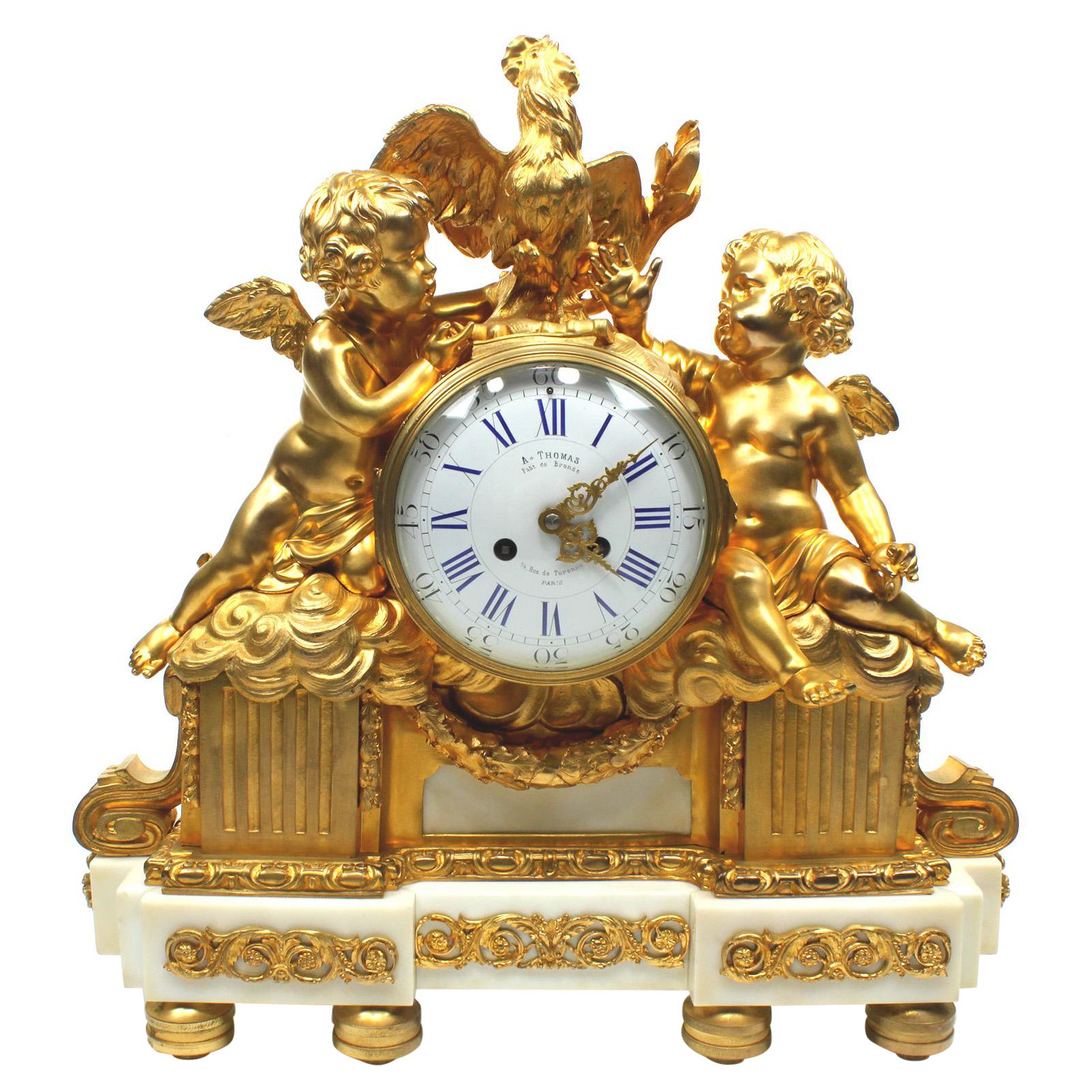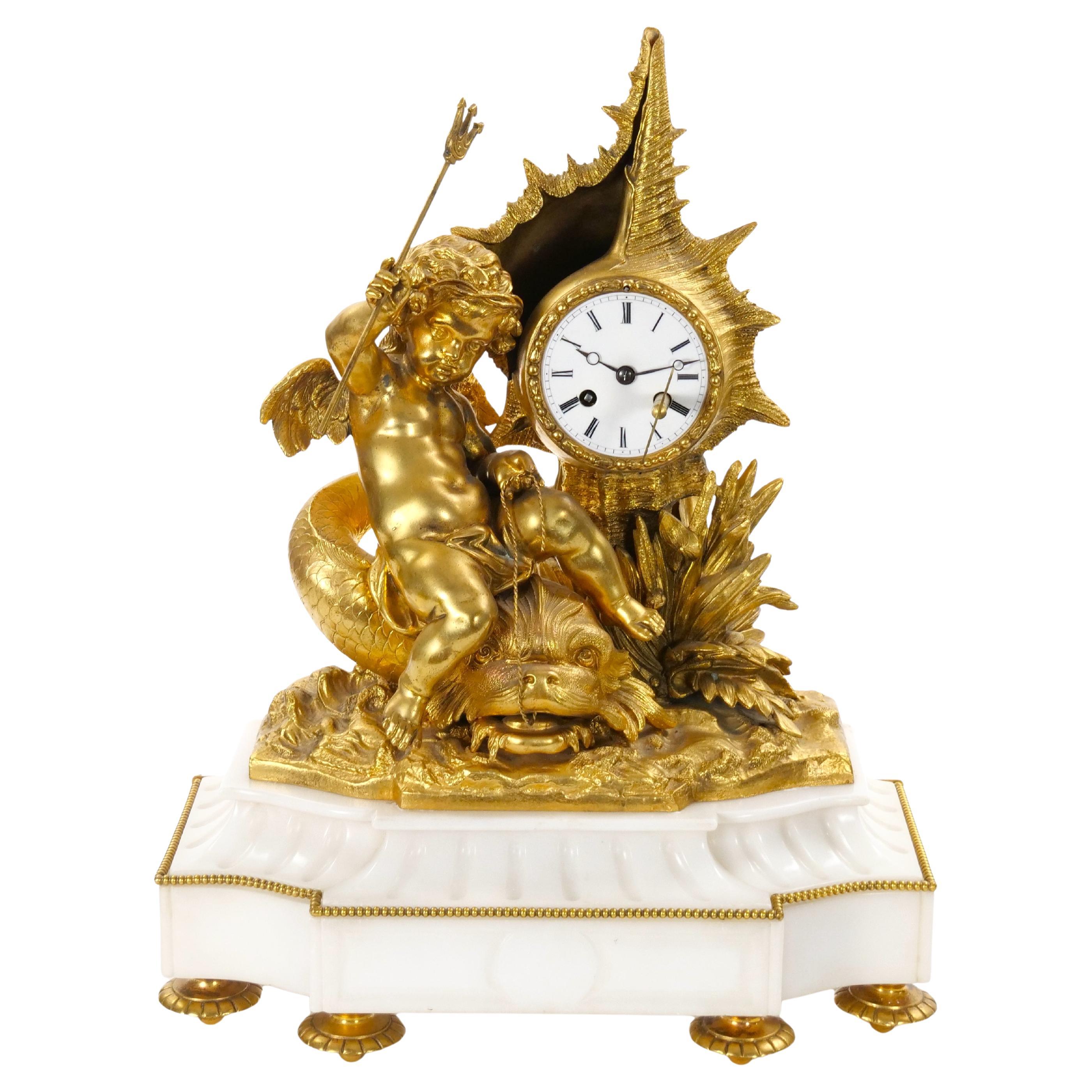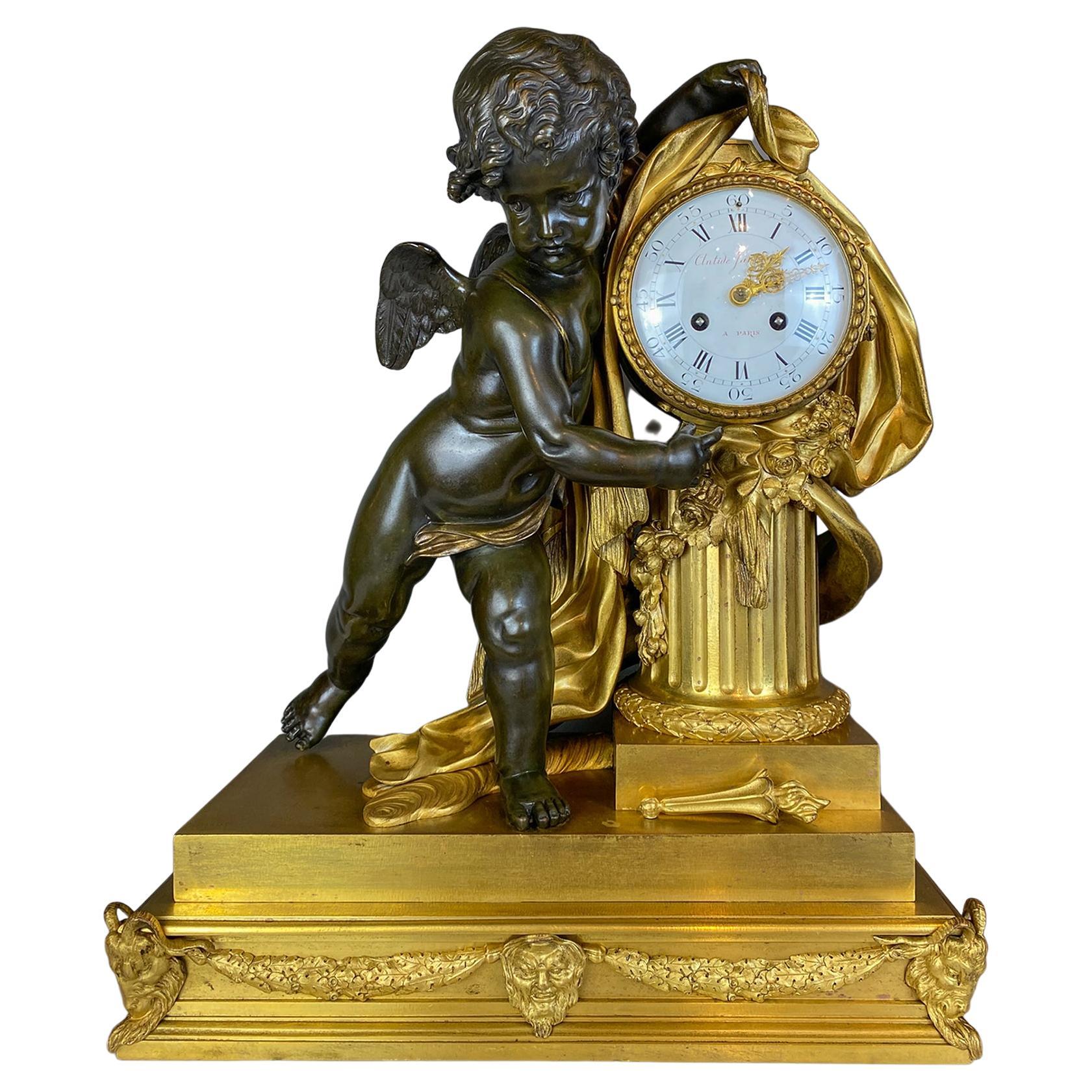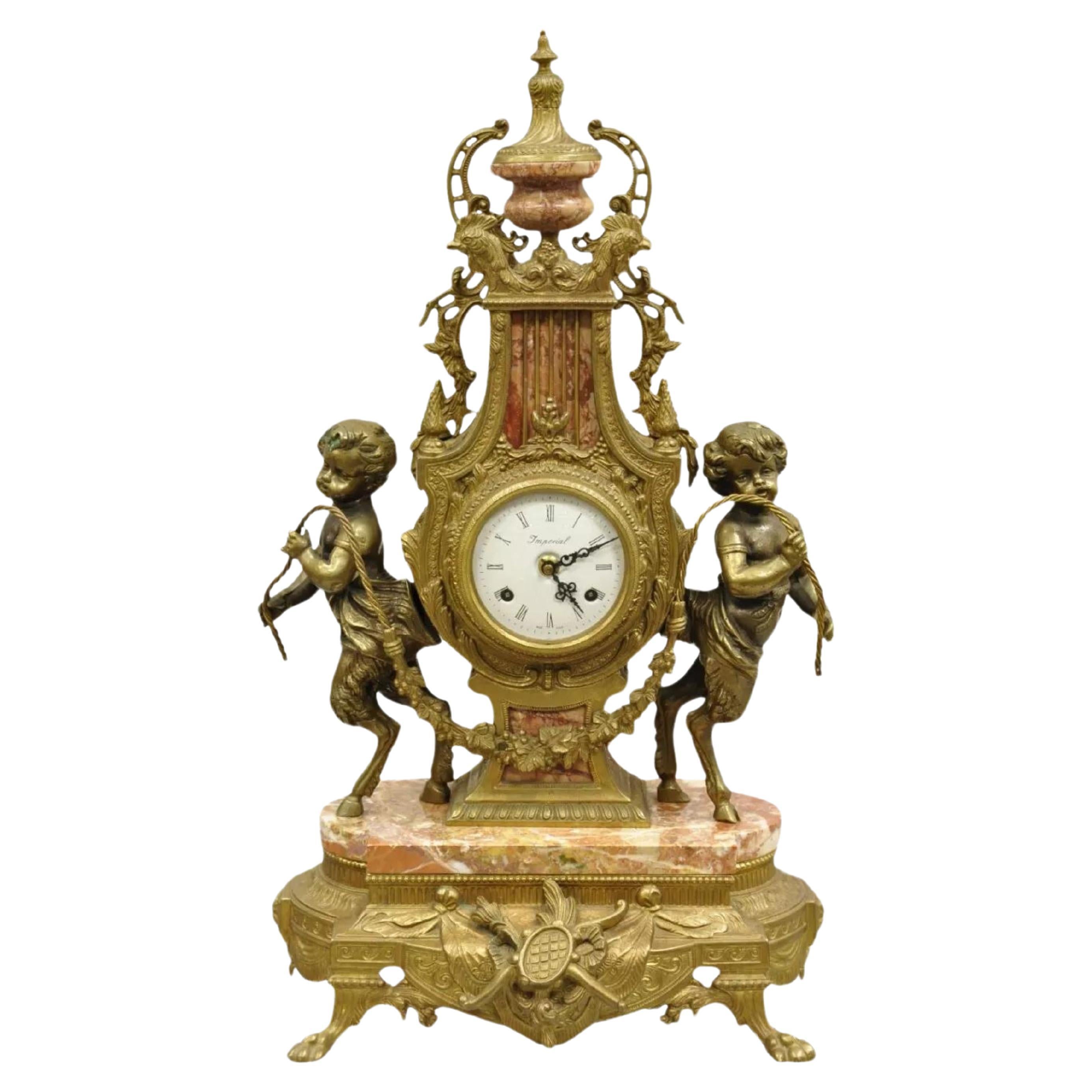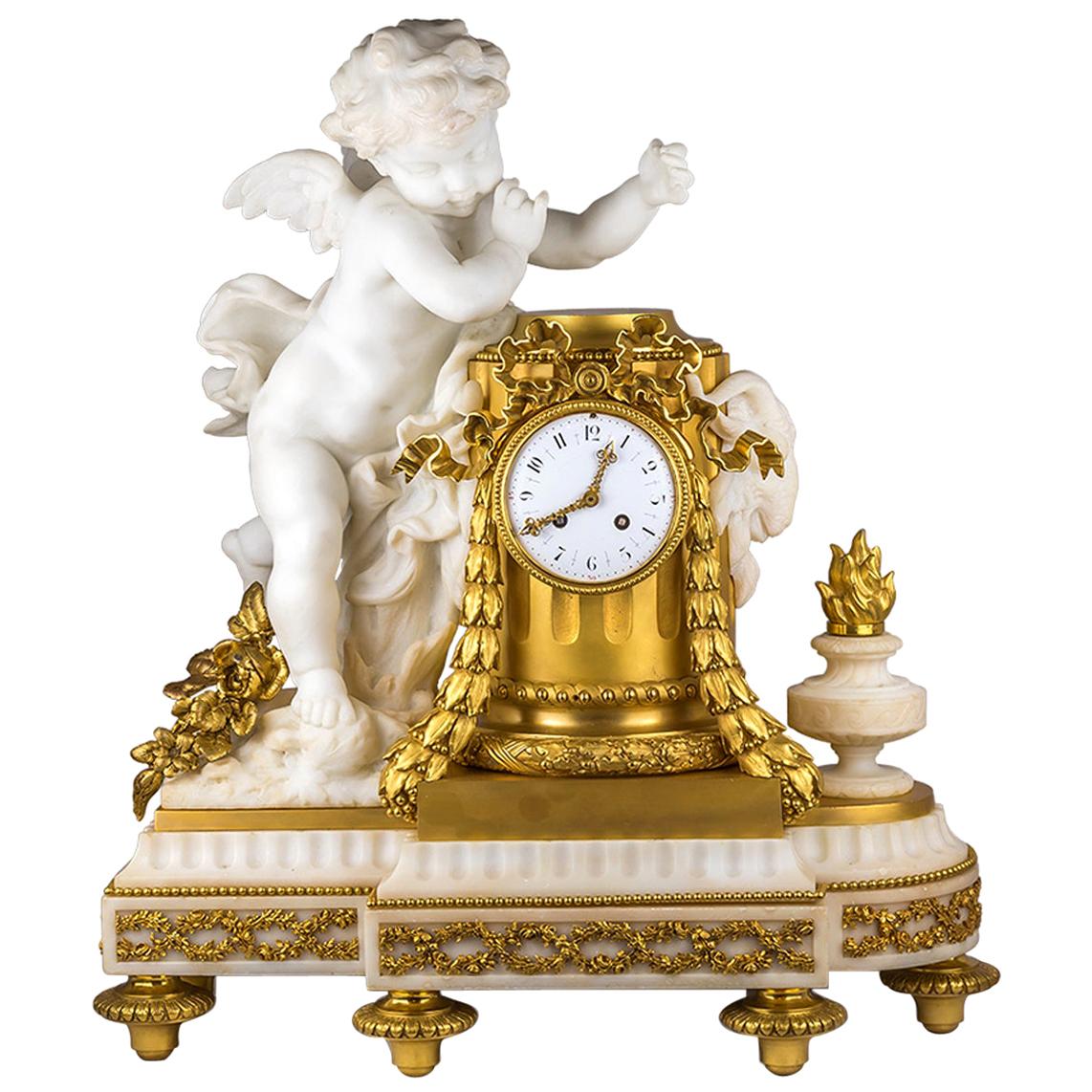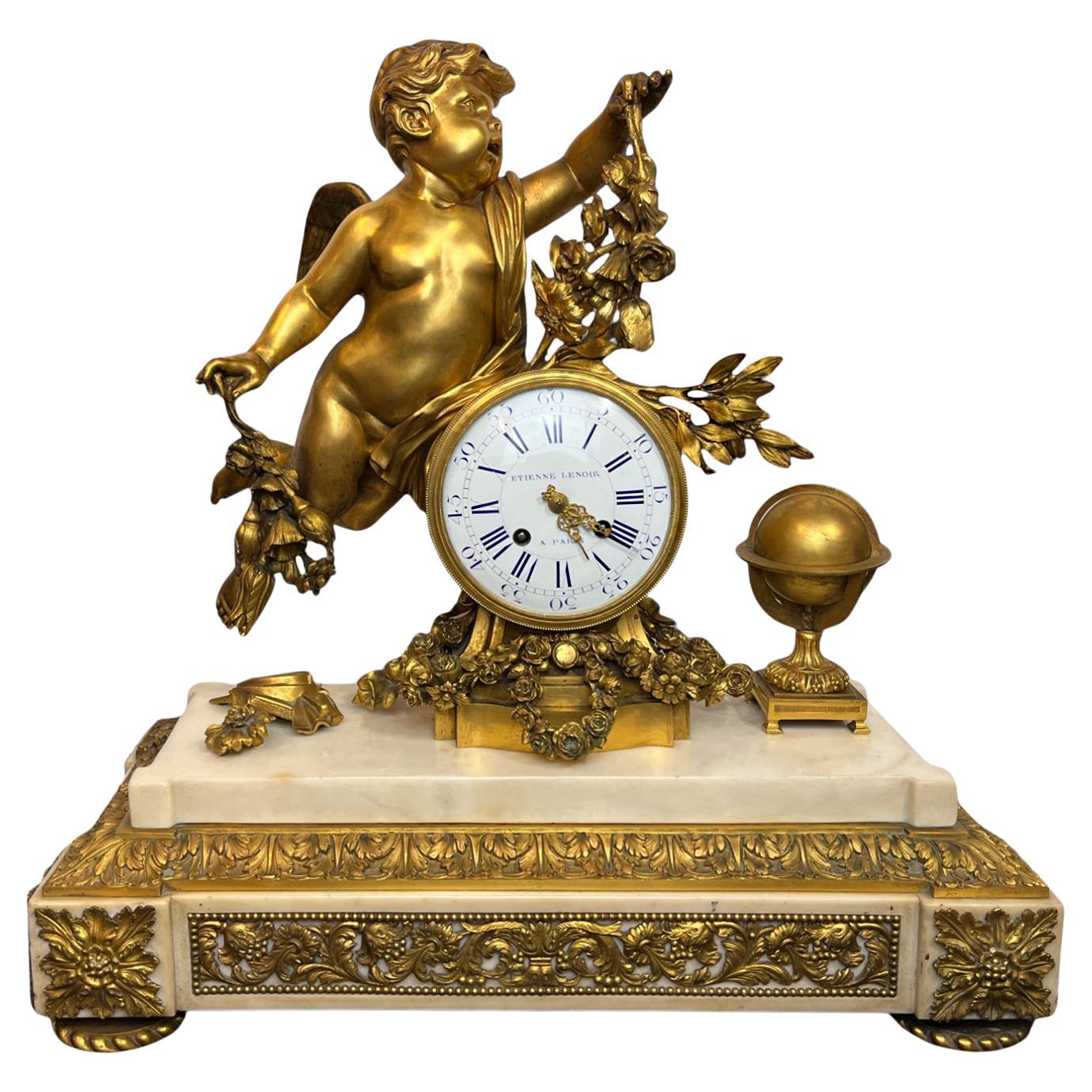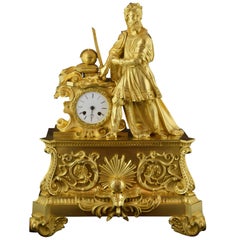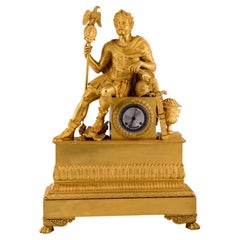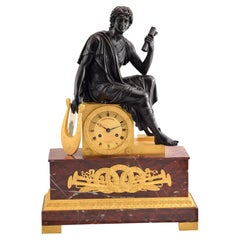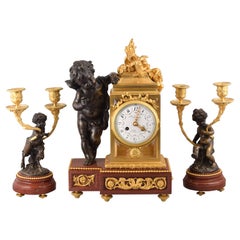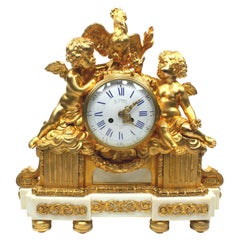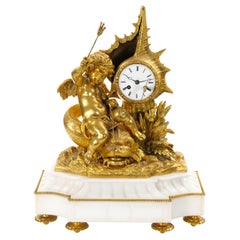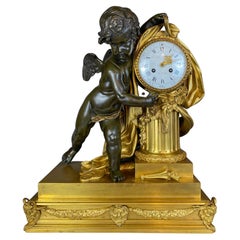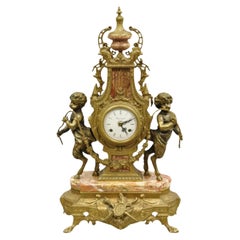Items Similar to Table clock, Cupid with rooster. Bronze, marble. Posib France, circa late 19th c
Want more images or videos?
Request additional images or videos from the seller
1 of 12
Table clock, Cupid with rooster. Bronze, marble. Posib France, circa late 19th c
$5,875.74
£4,484.85
€5,000
CA$8,282
A$9,095.24
CHF 4,749.71
MX$108,555.51
NOK 60,174.23
SEK 56,084.75
DKK 38,090.36
About the Item
Table clock. Gilt and blued bronze, marble base. Possibly France, late 19th century.
Working.
Table clock with Paris machinery in working order that has a rectangular light marble base with the front slightly forward to allow space for the clock case. It has a white dial, Louis XVI type hands and Roman numerals for the hours and Arabic numerals five by five for the minutes. This part is sheltered in a golden marble pedestal, which has a base of Greek fretwork resembling waves, a laurel wreath and, on the sides, some books, an overturned vase with flowers and an arch; above, plant elements and a bow. In the upper part there is a gilt bronze rooster, and, holding the animal, appears a cupid (note the bow that would link him to the god of love Cupid) or a blued bronze cherub, thus creating a marked contrast. A few examples similar to the present one are known in European private collections, since it was a highly prized model of which the French workshops specialized in this type of piece created some variants for watchmakers who requested them. There is also another model without a rooster and with the angel lying down, very similar to the present one, of which porcelain examples created in Meissen are also known. ·
Size: 35x15x40 cm Weight aprox 16 kg.
International Buyers – Please Note: for those articles that need Export Permits (those older than 100 years), the obtaining of the Permit will be processed without additional expenses (if you choose the seller sends it to you), but the period for the obtention of it may vary from 10 to 35 days.
- Dimensions:Height: 15.75 in (40 cm)Width: 13.78 in (35 cm)Depth: 5.91 in (15 cm)
- Style:Neoclassical Revival (Of the Period)
- Materials and Techniques:
- Place of Origin:
- Period:
- Date of Manufacture:Late 19th century
- Condition:Wear consistent with age and use. Minor losses. Minor fading.
- Seller Location:Madrid, ES
- Reference Number:Seller: zf10361stDibs: LU2951332702112
About the Seller
4.9
Vetted Professional Seller
Every seller passes strict standards for authenticity and reliability
Established in 1985
1stDibs seller since 2017
353 sales on 1stDibs
Typical response time: 20 hours
- ShippingRetrieving quote...Shipping from: MADRID, Spain
- Return Policy
More From This Seller
View AllTable Clock, Ormolu, 19th Century
Located in Madrid, ES
Table clock made of gilded bronze with a powerful base, enhanced with legs decorated with vegetal and architectural motifs of classicist inspiration and a series of details on the fr...
Category
Antique 19th Century European Neoclassical Mantel Clocks
Materials
Bronze
Table clock, Aníbal Barca. Ormolu bronze, metal. France, 19th century.
Located in Madrid, ES
Table clock, Aníbal Barca. Ormolu bronze, metal. France, 19th century.
Table clock with Paris machinery and a case made of mercury-gilded bronze. in mercury-gilded bronze, with a rectangular base on four rectangular base on four legs (the front ones decorated with scrolls and decorated with scrolls and ending in claws), decorated with a series of mouldings in relief with vegetal and architectural elements. vegetal and architectural elements in relief. The dial The dial (metal with Roman numerals for the hours) is set within a square shape, on which sits the male figure that decorates the piece. A bearded man, dressed in armour (a muscular loriga or cuirass) and a cape fixed over one shoulder with a fibula, resting his left arm on the helmet holding a rolled-up document, and with his left hand document, and with his left hand he holds a Roman standard (another Roman standard (another is broken, under his foot). Note, to the right and next to a sword, a vase full of rings.
vase full of rings.
Hannibal Barca (247-183 BC) was a Carthaginian general and statesman who was well known for his Carthaginian general and statesman, well known for his the ancient Roman Empire. No He was often depicted as counting the rings of fallen Roman knights in
the fallen Roman knights at the battle of Cannas (216 BC). , as can be seen in the sculpture by
sculpture by Sébastien Slodtz (made in 1704, Louvre Museum, Paris), where he also carries a Roman banner. Roman standard. With these two elements (vase with rings and with rings and a banner) is also shown on a table clock...
Category
Antique 19th Century European Neoclassical Revival Mantel Clocks
Materials
Bronze, Other
Table Clock, Apollo, Bronze, Marble, Model of Lenoir-Ravrio, Louis-Stanislas
Located in Madrid, ES
Table clock, Apollo. Bronze, marble. Model of Lenoir-Ravrio, Louis-Stanislas(1783-1846). Paris, around 1820.
Table clock composed of a staggered rectangular base made of red veined...
Category
Antique Early 19th Century French Neoclassical Mantel Clocks
Materials
Bronze, Other
Clock Set, Bronze, Rouge Griotte, Etc, France, 19th C. After Clodion
Located in Madrid, ES
Clock garnish and two candlesticks. Bronze, rouge griotte marble. France, 19th century, following Clodion's models.
Set or garnish consisting of a table clock and two candlesticks ...
Category
Antique 19th Century French Neoclassical Table Clocks and Desk Clocks
Materials
Griotte Marble, Bronze, Other
Table clock. Bronze. 1990s, modeled after August Moreau.
Located in Madrid, ES
Table clock. Bronze. 1990s, modeled after August Moreau.
In working order. at origin
Table clock with a raised base and gilt-bronze legs following 19th-century models and a white ...
Category
20th Century European Other Table Clocks and Desk Clocks
Materials
Bronze, Other
Clock with sculpture. Bronze, stone. Coupier Fila and Provart, Paris, France.
Located in Madrid, ES
Clock with sculpture. Bronze, stone. Coupier Fila and Provart, Paris, France, late 19th century.
Bronze sculpture depicting a boy sitting on a rock formation, raising one bare foot ...
Category
Antique 19th Century French Other Table Clocks and Desk Clocks
Materials
Stone, Bronze, Other
You May Also Like
French 19th Century Louis XV Style Gilt Bronze Cherubs & Rooster Mantel Clock
Located in Los Angeles, CA
A very fine French 19th century Louis XV style gilt bronze and white marble figural mantel clock. The finely chased ormolu body, with its original two-tone mercury gilt, centered with a circular enameled porcelain clock face with Roman and Arabic numeral dials and inscribed 'A. Thomas - Fabt de Bronze - 56, Rue de Turenne - Paris', surmounted with a pair of playful seated cherubs amidst clouds and wreaths, the case crowned with a figure of a Gallic Rooster (Coq Gaulois...
Category
Antique Late 19th Century French Louis XV Mantel Clocks
Materials
Marble, Bronze, Ormolu
$14,950 Sale Price
21% Off
Louis XVI Gilt Bronze / Marble Mantel Clock Featuring Cupid & Triton, Italy 1834
Located in Tarry Town, NY
A superb example of neoclassical artistry, this antique Louis XVI style mantel clock was crafted in Italy circa 1834. Rich in symbolism and detail, the clock features a finely cast g...
Category
Antique 1830s Italian Louis XVI Mantel Clocks
Materials
Marble, Bronze, Ormolu
Fine Gilt and Patinated Bronze Mantel Clock with Putti by A Paris
By Antide Janvier
Located in New York, NY
An exquisite figural bronze mantel clock with Putti leaning on clock face which sits on a fluted column draped in garlands and fabrics. Sitting on a r...
Category
Antique 19th Century French Mantel Clocks
Materials
Bronze
Vintage French Louis XV Style Brevetatto Italy Brass Marble Figural Cherub Clock
Located in Philadelphia, PA
Vintage French Louis XV Style Brevetatto Italy Brass and Marble Figural Cherub Clock. Item features an ornate figural clock with hoof foot cherubs and pink marble accents, German clo...
Category
Late 20th Century Louis XV Mantel Clocks
Materials
Bronze
19th Century French Ormolu and White Marble Winged Cherub Clock
Located in New York, NY
Exquisite Quality French Ormolu and White Marble Winged Cherub Clock.
Date: 19th century
Origin: French
Dimension: 25 1/2 in. high, 23 in. wide, 10 1...
Category
Antique Late 19th Century French Mantel Clocks
Materials
Carrara Marble, Ormolu, Bronze
A Louis XVI Ormolu and White Marble Mantel Clock of Cupid
By Etienne LeNoir
Located in New York, NY
A Louis XVI Ormolu and White Marble Mantel Clock of Cupid
A magnificent and large clock with gilt bronze Cupid mounted to the clock face. He is flanked by a painter's palette and a...
Category
Antique Late 19th Century Louis XVI Mantel Clocks
Materials
Marble, Ormolu
More Ways To Browse
Blue Bronze
Bronze Cupid
French Porcelain Vase With Cherubs
Marble Cupid
Bronze Rooster
Neoclassical Marble Clock
Cupid Clocks
Blue Cherub
Cupid Mantel Clock
French Clocks Cupid
Link To Love
Cupid Table
Mantel Clock With Angel Gold
Antique Rooster Clock
Rooster Clocks
Marble Table Clocks With Bronze Angels
Art Deco Marble Clocks
Unusual Antique Clocks
